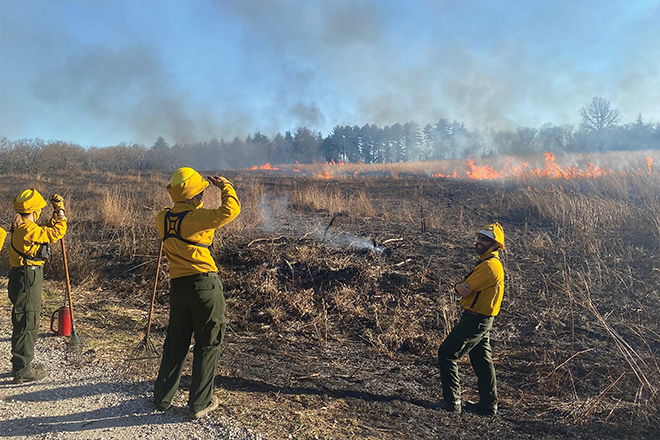Photos by David Jacobs
Exciting collaborations are happening to get more fire on the ground, reverse the habitat degradation trend, and provide high-quality habitat for quail and other wildlife
By Kim Cole
Prescribed fire, or controlled burning, is an important and highly impactful tool for restoring and managing a diversity of habitat types. Controlled burns are a cost-effective way to restore native plant communities and control invasive species, reduce fuel loads to lessen the chance and intensity of damaging wildfires, and quickly enhance numerous acres of wildlife habitat. Even with many clear benefits to utilizing prescribed fire, it is a tool that you won’t find in the toolbox of all land managers.
Historically, fires occurred naturally on the landscape with lightning strikes and were used by Native Americans to distribute bison, which played an important role in shaping natural communities that are composed of fire-adapted plant species and support many different species of wildlife. Over time, fire on the landscape was suppressed to mitigate damages to property from wildfires. Fire wasn’t a desirable management tool to use because of the risk. But the negative impacts on habitats from a lack of fire, like overgrown woodlands, build up of vegetative fuel, and encroachment of undesirable plant species to name a few, became apparent. Without the presence of fire to manage natural communities, habitats have degraded and are less able to support our cherished wildlife, especially quail, a species that thrives in habitats maintained with fire (and is appropriately dubbed the firebird).
In Missouri, the subject of prescribed fire is a hot topic and there are some exciting collaborations happening to get more fire on the ground, reverse the habitat degradation trend, and provide high-quality habitat for quail and other wildlife. One of those collaborations is a brand-new habitat specialist crew — a first for Quail Forever and Pheasants Forever in Missouri — that has boots on the ground and is focused on using prescribed fire to enhance native habitat in east-central Missouri. Made possible through a unique partnership between the Missouri Department of Conservation, Shaw Nature Reserve and Quail Forever, and supported by generous donations from Nestlé Purina, Steve and Jeanne Maritz, and Roeslein Alternative Energy, the habitat specialist crew that formed in winter 2021-2022 wasted no time getting prescribed fire on the landscape to help manage valuable native communities in Missouri.

The crew in Missouri, a team of three, has been working with key partners to coordinate and conduct wildlife habitat management practices on cooperating lands, with an emphasis on the application of prescribed fire. Stationed at Shaw Nature Reserve in Gray Summit, Missouri, Dylan Jacobs serves as the crew leader and Abbey Ward and Benjamin Clevenger are the two habitat specialists that round out the crew. Eager to collaborate with partner staff and get right to work, the crew has already joined up with staff at Shaw Nature Reserve and the Missouri Department of Conservation to conduct several prescribed burns and implement other habitat management practices that have had a positive impact on many acres of wildlife habitat in east-central Missouri. They have even spent time with the Quail Forever habitat specialist crew in Arkansas to get hands-on training and assist another habitat crew with conducting prescribed fires on priority landscapes.
“Dylan, Abbey and Benjamin bring a wealth of knowledge and extensive experience with prescribed fire to the team,” said Andrew White, Missouri State Coordinator for Quail Forever and Pheasants Forever. “All three are valuable additions to the Quail Forever and Pheasants Forever Missouri team and we’re excited to see the positive impact the habitat specialist crew will have on the landscape. They will form a strong foundation for the newly formed habitat crew and be blazing the trail for other Missouri habitat teams in the future.”
Because of the ongoing support and involvement of many partners and donors, we now have a habitat specialist crew on the ground in Missouri! Our partners make our work possible, so we extend to them our gratitude. Working together, we can all enhance habitat and sustain a healthy environment for wildlife!
If you have questions or want to learn more about the habitat specialist crew in Missouri, contact crew leader Dylan Jacobs at djacobs@quailforever.org.
Kim Cole is a Quail Forever's Missouri Outreach Coordinator.
This story originally appeared in the spring issue of Quail Forever Journal. If you enjoyed it and would like to read more great upland content, become a member today!